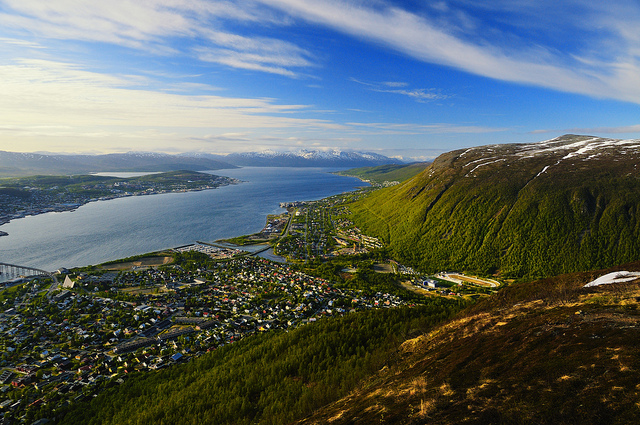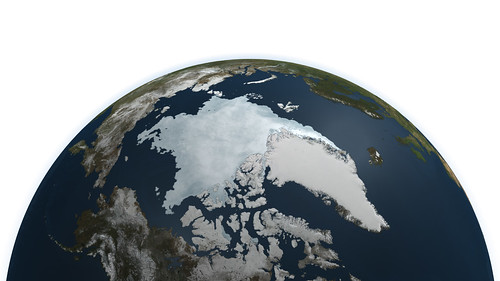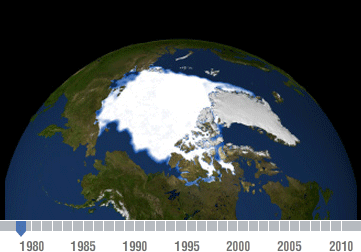2 Search Results for: sea ice arctic minimum
Arctic defrosting faster than ever
With the world expecting to celebrate world records at the London Olympics from today, the weather in recent weeks has delivered many high scores we should be less happy with: Record breaking high temperatures in the USA, droughts in Canada or deadly floods in Russia are just the most prominent examples.
Now there’s more. This summer, ice in arctic regions has been melting more extensively than ever seen before.
NASA scientists reported that in mid-July a whopping 97 percent of Greenland’s ice surface was melting. While the amount of surface melting can change extensively and in a matter of days (depending on the temperature of the air above), it’s never been observed to cover that large an area in more than 30 years of satellite observations.
Is this just a freak event or global warming in action? Scientists are careful not to draw a direct link between extreme weather events and climate change. For good reason: Some phenomena may not have been observed before, but scientists are not surprised to see them regardless of a global warming. Cores drilled out the Greenland ice sheets can help recover the temperature history for the place and indicate that extreme melting regularly occured every 150 years or so. This summer’s thawing episode is “right on time”, says one NASA glaciologist.
But the accumulation of extreme weather events is something you would plausibly expect under conditions of global warming, says Global Ideas climate expert Anders Levermann of the Potsdam Institute of Climate Impact Research. Even then, “we can’t say what the further impacts will be,” he cautions. In the case of Greenland “we don’t know what a period of extreme melting actually means except that in this moment more water is being lost and the water level is rising.”
Taking a long hard look at individual regions, however, can help establish more direct links between regional trends and global warming. At least 70 percent of the reduction of Arctic sea ice over the last 30 years may be man made suggests a study by a British-Japanese team of scientists. Here’s how the lead author puts it:
Exploring the North – Further North
Arriving in Tromso, Norway, we are now located just at the Arctic’s doorstep. It is a quiet strange feeling, when you suddenly stand at the edge of something, that is normally so incredibly far away. If it’s far away from you as well and you derive from that that you don’t have to care – hang on. You actually should, as the Arctic often is referred to as earth’s air conditioner. And on hot summer days without (working) air conditioning, you feel perfectly well what it is good for.

Thought you might have seen enough snow, so I found this Tromso view of June 2010 for you (Photo: CC-BY-NC-SA-2.0: Nietnagel)
If you look at such pictures of the Arctic region it does not at all like an air conditioning. I was actually suprised that it can be that green in the Arctic region, as I always associate of snow and ice with Artic. What about you?
But this ice is only there in winter time – that’s when it fulfils it’s cooling job, by reflecting 80 percent of sunlight back to space which then cannot heat up the ocean or earth anymore. But from March on, ice starts melting due to increasing temperatures. The decreasing sea ice cover uncovers the dark oceans that absorbs the sunlight instead of reflecting it – the cooling air conditioning turns into a heating facility.
So far, the Arctic yet hasn’t been completely ice-free during the warm summer period. But you might remember scientists worrying last summerabout the small area that is left ice covered: The larger the ice free part, the more heat is absorbed by the ocean underneath – in turn, even more ice melts and a vicious circle starts.
Not on the edge of the Arctic, but on the edge of Arctic research, you find scientists working on how this influences the Arctic environment. Sometimes this influence can even be positive: Researchers recently found that microbes in the soil can fix more carbon in a warmer climate.
But yet, researchers cannot tell how Arctic ice cover will evolve, but they work for example on better models to predict what is going to happen. That is especially important, as many earth systems are connected: A warming Arctic sea also affects ocean currents for example, that – connected to each other – span over the whole planet. In turn, oceans take up less CO2 for example, and in consequence more of this greenhouse gas in the air, warms up the whole planet.






Feedback